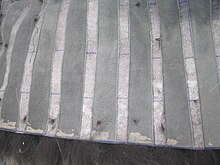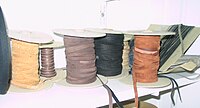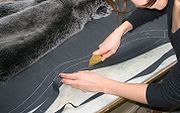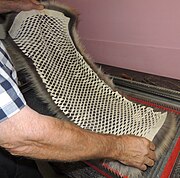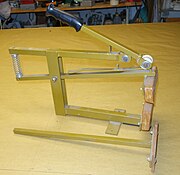Galloping
The Galonieren or Galonage (in Austria also Bandeln ) is a work of art Skinning can be enlarged with the skins in the area. This is done by sewing in alien material (galon - French galon , as much as braid or braid), such as leather or textile tape in or between fur surfaces. Galoning can be used in such a way that the galons are covered by the hair, or that they are visible, in order to achieve special effects. In the case of arctic fox fur in particular , it also leads to the desired loosening of the matted hair. If the costs to be incurred for planking are lower than the value of the saved skin material, planking can be used to reduce costs.
The gallooning always serves to shape. A distinction is made between parallel galons and wedge galons. Parallel galons result in a greater fur length or width, depending on the cutting system. Wedge galons create curves.
When feathering , a variant of galoning, the stripes used are marked on the side of the hair or are visible if the width is appropriate.
A separate technique is air gallooning , regular incision of the hide leather and subsequent stretching (" purposes ") to form a net-like structure. In addition to saving material, the result is a significant reduction in the weight of the garment and also a loosening of the hair.
history
In 1877, a furrier noted in his patent specification that " Galonnier has been used for centuries ". Not only in the Balkans, when the purchasing power of the inhabitants was low in the 19th century, the furriers who were strongly competing there used gallooning " for reasons of economy and cheapness ". The somewhat earlier beginning to galon on a larger scale is also indicated by a smokers' knowledge from 1864: “ In addition to the Chinese furrier work, we know the best: sable and fox fodder from the imperial cabinet furrier in St. Petersburg , the German and French galonage work in the second decade of our century ... ”At the Vienna World Exhibition of 1873 , Mr. R. Rzywnatz from Prague brought a raccoon skin“ in one pile over galonized (banded) travel fur , and one with galonized white fox lined women's travel coat made in the same way for inspection ", which" deserved to be called 'art work' in the true sense of the word ". At the same point it is mentioned that in China, where the preparation of fur was already well known than in the western world, the omission, letting in and galoning was just as good as in Europe.
With the invention of the fur sewing machine before 1900, sewing-intensive work techniques such as skipping and galoning became considerably cheaper. Nevertheless, in 1897 a galonized white or blue fox fetched twice the price than an ungaloned fox.
In the beginning, galoning was mostly done with lengthways, often textile ribbons. In the case of lengthways galonizing, however, there is a very high probability that the galons will become unattractive on the hair side, and so refined techniques were already in use in the 1920s. When the white foxes became expensive at that time, galonization in the USA was so extreme that one could make eight pieces from one fur instead of two collars.

For the beginning of the 20th century, “ the gluing process used earlier in France and, unfortunately, partly also in Germany ” is mentioned, but it “ must be decisively rejected because it makes subsequent reworking almost impossible ”. In fact, a German, Friedrich Erler from Leipzig, had already patented this process in Germany, France and England before 1895. It consisted of “ not attaching the galons to the leather with a seam as before, but with an adhesive. Although the process was not quite naturalized in the beginning and met with great doubts, it has proven itself to such an extent that it not only saves 30% of the work, but also objects treated in this way can be dyed with immersion paint without any disadvantages. “The galon strips were glued to a fabric base with rubber adhesive. Perhaps the disadvantages outweighed it, because the process, which was primarily intended for cheap types of fur, has apparently not been able to establish itself in the long term.
In 1891 a furrier describes the possibility of cutting the skins in the usual way, then stretching the skins and then fixing them with an iron-on rubber piqué. However, in 1928 a colleague also had doubts here as to whether the method would lead to a lasting result. In the meantime, the industry makes various different iron-on fixing materials available, the doubts about the durability of the fixing for this application have remained. On the other hand, methods in which the strips of fur are sewn onto a textile substrate are permanent. For this purpose, the furs are often cut into wavy, usually very narrow strips and applied to the fabric, often used for fur linings . However, the term galonizing is not used for this type of skin processing.
In addition to white fox skins, blue fox skins and silver fox skins are particularly suitable for galoning, which is as invisible as possible from the hair . Galoning has been used since around the 1960s to achieve special effects, even on many types of fur that are traditionally unsuitable. If the under hair is torn apart while sewing and the undercoat or even the leather strips used become visible, this is called feathers according to the resulting pattern . This new look and the resulting price reduction contributed to making the long-haired fur and particularly inexpensive rabbit coats attractive for young women.
In the course of time, the aids for recording the incisions and cuts during air gallooning have been further developed. Drawing by hand and cutting with a skinning knife is very labor-intensive. The distances at which the cuts can be made are also limited by the inaccuracies of manual cutting. Today it is possible with the appropriate equipment to make the cuts as tight as the leather just allows, without tearing.
Galonizing with leather or textile strips
Galoning can be used
- to enlarge the area, while at the same time flattening the hair level (smoking reduction)
- to reduce the formation of combs between two skins where the hair collides strongly during processing
- to achieve fashionable effects
- to save fur material and thus to reduce the manufacturing costs or the sales price
Leather or textile fabrics can be used as the fabric. Leather is preferred by furriers because, like fur leather, it is elastic and deforms when the fur that is moistened on the leather side is stretched. Galon leather is available in prefabricated form in specialist shops or is individually cut by the fur processor. In the ideal case it has the same thickness as the fur leather, this offers the greatest security against buckling and thus breaking the hair fleece during later use. For use Porc (cheap), calfskin (easy) or cowhide . Since only textiles with a selvedge can be used for sewing in with the fur sewing machine, only woven tapes of the appropriate width are used, preferably twill weave . About after the Second World War, the experts recognized that the elegant stripe effect was enhanced by 4 to about 6 millimeter wide fur galons between the stripes of omitted mink coats, while at the same time some skins could be saved (an idea probably imported from North America). At first, velvet ribbons were preferred because the hair sticks to them and covers the galons well.
According to the formulation of the furrier Hans Münzner from 1983, “all pelts, their hair structures, guard hair and undercoat, but above all their color gradations to each other and in the individual hair and in the different hair lengths, a first wide opening to be tried out of two opposing hairs are suitable Allow fur edges completely invisible ".
The arctic fox hair is significantly softer than that of the red fox, the undercoat is so matted that you cannot see the leather when you blow it into it. In the finished fur, even interposed leather strips cannot be found if they were sewn in according to traditional furrier art without tearing the hair fleece. Galoning was therefore initially used especially for arctic fox skins. In addition to increasing the area of the fur, it also leads to a loosening and beautification of the hair image by a certain steepness of the hair. Because of the extremely dense, matted undercoat, the arctic fox does not run the risk of seeing the sewn-in leather strips when the fur is moved. Arctic fox skins are relatively short, so that the once so popular fox necklaces could not be made from one skin without galonizing, especially if the underside should be made of fur and not silk. The relatively short tail of the arctic fox can also be lengthened with galons. Other types of fur to be galonized to cover the hair are, in addition to foxes, in particular noble foxes, wolf skins , lynx skins and other long-haired, densely haired skins.
Only the particularly thickly woolly core of the fox fur is galonised, the cross and the sides are left out. At regular intervals to the middle of the fur, diagonal cuts are made at a distance of 1 to 1.5 centimeters, in which the leather is only just scratched through with the skinning knife without damaging the hair. The fur sewing machine is used to carefully sew in strips of leather or ribbon, the galons, not more than 1 centimeter wide, without tearing the fur felt. In principle, the undercoat must not be separated when cutting, sewing and stretching (purposes), as the cuts later break at these points, i.e. they become unattractively visible in the hair. The previously cut skin sides can then be adapted to the now longer back part with the help of so-called outlet cuts.
The coat is lengthened with cross braces, widened with braids sewn in lengthways, and curves are achieved with wedge braces. With partially inserted galonings, smaller areas that are missing compared to the pattern can sometimes be added in an elegant, clean way without additional fur material. Galons can be used between fur connections, for example between processed mink strips and other marten strips as well as all long-haired fur types. To avoid the formation of combs in bumping hair, galons are used primarily in the middle of collars and in the middle of the back of furs that are worked across the hairline. In order to avoid buckling due to the hair pressing against each other, these galons should be stiffened on the back. Since the galons are covered when the hair is bumped, their maximum width depends on the length of the hair. In the case of long-haired skins, a galon can therefore also be of different widths, narrowing towards the thin sides of the fur and towards the edge of the collar. Always galoniert Nerzschweife if it for further processing into tablets, so-called bodys are processed. The 1950s and 1960s were caps and Peter Pan collar from Nerzschweifen very fashionable, even this were sewn in between and in the tails always Galons.
A variant of galonizing with leather strips is to first galonize the suitable piece of fur completely across or lengthways, leather and fur strips in the same width. At right angles to this, the galonized part is then cut again into strips of the same width and, shifted by one strip width, sewn together again. The leather is then distributed like a chessboard, every other check is made of fur.
- Galonizing with leather or textile ribbons
- Galon effect of a gray-colored blue fox coat (Designer: Guliya Baykieva, 2008/2009)
feathers
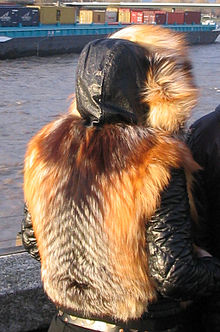
While leather strips were initially laboriously used so narrow that they were not noticed by the hair side, the technology has been used since around after the Second World War, primarily to produce fur parts that are as inexpensive as possible. The wider the fur strips, the more fur was saved and at the same time the working time was reduced. If galloping is combined with the technique of letting out , a feather-like zigzag pattern is created in the overall look. The term feathers is derived from this for the galonising with the noticeable effect on the hair side, the falling and rising of the hair profile, up to visible galons. When leaving out, the fur is cut into V- or A-shaped narrow strips. By shifting the strips against each other before sewing them together, the skin is lengthened when it is left out at the expense of the width. When feathering, a leather or textile strip is sewn in between each strip of fur. Since the strips of fur can be very narrow (minimum about 5 millimeters) with the appropriate hair length and fullness, but the leather strips can be as wide as desired, such a piece of clothing may only consist of a fraction of fur.
The cutting of the skins is carried out as with skinning, if possible with skin cutting machines. These tools have rotating knives under which the skins are passed and cut. Different cutting widths can be achieved by changing the knife rollers. Around 2010 a device was developed in Belgium that cuts the skins by simply pressing in small knives, similar to the models by the same inventor for air gallooning.
Since the seams create an appealing pattern when feathering, the technique is also used to make reversible furs where the leather side can be worn outwards. The back of the fur is usually napped or velouted, for the galons, color-coordinated colors, contrasting colors or even patterns are possible. Several types of fur can also be mixed here, so that completely new effects are also created on the fur side. For the technique, all types of fur with tear-resistant leather, curly or smooth-haired, about the size of a mink fur , can be considered. In the past, common types of fur for this purpose were, among many others, mink, Persian , Tasmanian opossum and noble foxes .
If the fashion changes from short to long coats or if a fur is passed on to a taller person, the furs in the body or sleeves can be elegantly lengthened by inserting galons without the impression of a subsequent change being created. This also eliminates the frequent problem of getting the right fur, especially if the fur has been colored or has changed color over the years due to exposure to light.
In contrast to the invisible, narrow-striped gallooning, in which the galon material is chosen as precisely as possible in the color of the coat, contrasting colors or colors or patterns corresponding to the respective fashion can be used for wide-stripe effect gallooning.
Air gallooning
When Luftgalonieren is dispensed with the sewing of leather strips. At short intervals, the core of the fur is scratched with about 1.5 centimeters long, staggered cuts, stretched while moist and, after drying, usually fixed with a fine gauze. The result is also an enlargement of the surface with a net-like leather structure, while at the same time loosening up the hair. The gain in space was estimated at 25 to 30 percent in 1986; with the most recently developed cutting aids, it should be significantly higher. With the T-technique, an additional longitudinal cut of the same length is placed under each cross-section, so that an incision in the shape of a T is created. This results in an even greater gain in space, and light curves can also be achieved. The maximum area gain here was estimated at 40 to 45 percent. Similar effects are achieved by cuts in the VA technique developed by master furrier Hans Münzner, who had this process patented in 1977. The skins are cut at an angle, V- and A-shape before they are stretched out. Attempts to carry out this technique efficiently by machine, possibly with automated laser cutters, failed because of the likely low acceptance of the devices. Münzner himself said, "This becomes understandable when you know that the annual incidence of raw fur from arctic foxes is relatively low". The U-process is the same as the VA technique, except that the semicircular cuts compared to the V or A-cuts do not create any sharp corners, and so the corners cannot straighten up even with less matted skins. The same inventor cites the area gain as 70 to 80 percent.
- Air gallooning
Air galloon aids and devices
As a rule, the various devices cut by simply pressing the knife into the hide leather, the hair side must not rest on a surface. This minimizes the risk of hair being cut off at the same time.
- For cutting with the skinning knife, templates created by the furrier himself or available in specialist shops can be used to apply the galloon cuts during air gallooning instead of individual drawing .
- A simple cutting aid was a Galonier knife , in which eight knives are cast in polyester across the width of the cut. It can be used until the knives are blunt.
- The Madl-Galoner comes from Rosenheim , and the knives are interchangeable. This includes a device in which the skin is clamped for cutting. In March 1974 it was presented for the first time at the Frankfurt fur fair.
- The Martor Stripex was developed from the Madl-Galoner after the license was granted. This also includes a clamping device that works with compressed air. The interchangeable blades are available in different widths, and according to the manufacturer, the device can also be used for galoning with galons.
- Martor also sells the Galonex roller galonizer , which can be set to the required cutting length. The cutting is also carried out using the clamping device by rolling from clamping jaw to clamping jaw.
- Lotti Mauri from Milan also offers a hand cutting device. Here the knives are arranged parallel to each other in acrylic glass handles of different widths. For cutting, the fur is placed on a kind of nail board, into which the hair is pressed during cutting so that it is not cut off. The knives can be guided with an acrylic glass template to be placed on top.
- The Fur Air Gallon Machine from Belgian furrier Germain Martens does the cutting very easily by simply pressing a lever. In addition, he has developed stenter frames that enable optimal use of space after cutting.
Marginalia
- In 1974, the New York garment manufacturer David Leinoff registered a patent for feathered fur clothing. In 1981 he brought a lawsuit against a well-known clothing company in which he sought compensation for patent infringement. A year earlier, he had already reached an extraordinary settlement in such a process, in which the defendant undertook to pay a license fee of 5 percent of sales of spring-loaded models. Other companies also paid this fee.
- The fur trader John J. Ehrmann reported on a visit to the physicist Albert Einstein in Princeton : “As far as fur coats are concerned, Prof. Einstein had the following theory:“ You should have holes in the places that do not fall into the eye of the beholder , so that the fur coats are lighter in weight and have more ventilation «“.
Literature, web links

- Compilation fur. Manufacture of fur , Volume I - B: 9.1.1. Diebel / Egon Beinhauer: Galoning and suspension technology . 9.1.2. Beinhauer: Air gallooning is getting easier . 9.1.3. Sepp Madl: Take a fox and some air . Collection folder, eds. Central association of the furrier trade, Bad Homburg, 1981 (first, unfinished edition)
- Video demonstration of the Fur-Air-Galon Galoning device (company website), last accessed on November 24, 2015
- Video demonstration of the production of a raccoon jacket, galonized with the Fur-Air-Galoner (company website), last accessed on November 24, 2015
supporting documents
- ↑ a b c Author collective: Manufacture of tobacco products and fur clothing . VEB Fachbuchverlag Leipzig 1970, pp. 335–337.
- ↑ a b Patent of the Imperial Patent Office No. 505, class 3, clothing industry, July 4, 1877. Secondary source: Sent from Friedr. Erler, Leipzig: A patent specification from 1877 . In: Der Rauchwarenmarkt , Leipzig August 11, 1939, p. 3
- ^ "Eh.": Skinning and finishing in Southeast Europe . In: Der Rauchwarenmarkt No. 20, Leipzig, May 15, 1936, p. 5.
- ^ Heinrich Lomer : The smoke goods trade . Leipzig 1864, p. 55
- ↑ Simon Greger: The furrier art . 4th edition, Bernhard Friedrich Voigt; Weimar 1883, p. 191. (130th volume in the series Neuer Schauplatz der Künste und Handwerke ).
- ^ Jean Heinrich Heiderich: The Leipziger Kürschnergewerbe . Inaugural dissertation, Ruprecht-Karls-Universität zu Heidelberg, 1897, p. 87.
- ^ A b David G. Kaplan: The Fur Book . Copyright The Reuben H. Donnelley Corporation, New York 1950, pp. 102-106 (English).
- ^ Fritz Hempe: Handbook for furriers . Verlag Kürschner-Zeitung Alexander Duncker, Leipzig 1932, p. 92
- ↑ Heinrich Hanicke: Handbook for furrier . Published by Alexander Duncker, Leipzig 1895, p.
- ↑ Paul Cubaeus, "practical furriers in Frankfurt am Main": The whole of Skinning. Thorough textbook with everything you need to know about merchandise, finishing, dyeing and processing of fur skins. A. Hartleben's Verlag, Vienna, Pest, Leipzig 1891, pp. 287-296
- ↑ Alexander Tuma jun: The practice of the furrier . Published by Julius Springer, Vienna 1928, pp. 109–114
- ↑ Central association of the furrier trade: Front fixation in the area of fur processing: process engineering - fixation materials - fixation values . In: ATF Recommendations No. 4/1974, Flensburg and Bad Homburg, p. 3. - Quotation (1974): “Fixing” has also been dealt with in fur clothing for about ten years, but attempts have always failed the non-usable interlining materials in connection with the pressure and temperature .
- ↑ a b Hans Münzner: Galonieren. In: Pelz International Issue 8, August 1983, pp. 31-34.
- ↑ Alexander Tuma: Pelz-Lexikon. Fur and rough goods. XVIII. Tape. Verlag Alexander Tuma, Vienna 1949. Keyword "Galonieren"
- ↑ Collection of fur. Manufacture of furs , Volume I - B: 25.1.1. Egon Beinhauer: Mink turning technique - Persianer . Collection folder, eds. Central association of the furrier trade, Bad Homburg, 1981 (first, unfinished edition)
- ^ Author collective: Der Kürschner. Technical and textbook for the furrier trade. 2nd revised edition. Published by the Vocational Training Committee of the Central Association of the Furrier Trade, JP Bachem Publishing House, Cologne 1956, pp. 52–53.
- ↑ Hans Münzner: Patent techniques for polar foxes. In: Die Pelzwirtschaft, No. 4, 1986, pp. 110-117. Patent DE 2719603 C3
- ↑ Leaflet of the company Sepp Madl, Hans Schober, Rosenheim: Madl-Galoner . Without date (before 2000)
- ^ Leaflet from Lotti Mauro, Milan: Galoner . Without a date
- ↑ Egon Beinhauer: Air gallooning ever easier . In: Pelz International No. 11, November 1974, Rhenania-Verlag, Koblenz, pp. 60-61.
- ↑ Without mentioning the author: New invention for the fur fair . In: Winckelmann Pelzmarkt No. 22, March 29, 1974, p. 16.
- ↑ Brochure of the company Argentax EH Beermann KG, Solingen: Martor ... and suddenly cutting is very easy . Without a date
- ^ Leaflet from Lotti Mauri. Without a date.
- ↑ If the author is not stated: Trial in the USA because of patent for feathered pelts . In: Winckelmann Pelzmarkt No. 609, September 11, 1981, p. 10.
- ↑ John Ehrmann: Prof. Einstein's idea for processing fur . In: Winckelmann Pelzmarkt No. 351, pp. 1–2.




